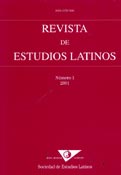The Polysemy of ius, iuris (‘law’, ‘dressing, sauce’) and the genuine idea (‘union’) of Roman Law
DOI:
https://doi.org/10.23808/rel.v10i0.87814Keywords:
ius; polysemy; homonymy; specialization; law; sauce.Abstract
Ius, iuris (‘law’ and ‘sauce’) was originally one word from the same root as iungere ‘to join together’). From the meaning ‘union’ that it had in ordinary language, it evolved into the two technical usages that are conserved in historical times. We believe that this hypothesis is supported by clear methodological criteria and by sound arguments. Because of this, we should not reject it for tenuous phonetic reasons or because of supposed semantic difficulties. If attention is paid to the difference between ordinary and special language, to the instrumental sense with which each meaning of ius develops into a technical term, the oral character of the legal ius and to the numerous analogies between legal, culinary and even medical formulae in different languages, the etymological unity of ius seems obvious.
Downloads
References
BENVENISTE, Émile, 1973: Origines de la formation des noms en indouropéen, París, Maisonneuve.
BENVENISTE, Émile, 1969: Le vocabulaire des institutions indo-européennes, 2. Pouvoir, droit, religion, París, Minuit.
CARCATERRA, Antonio, 1968: Struttura del linguaggio giuridico-precettivo romano, Bari, Cacucci Editore.
CARNELUTTI, Francesco, 1947: «Di là dal diritto», Rivista Italiana per le Scienze Giuridiche 84, 108-116.
CATALANO, Pierangelo, 1987: «Ius / iustitia / Iustitia», Enciclopedia Virgiliana, Roma, Istituto della Enciclopedia Italiana, vol. III, 66-72.
COSERIU, Eugenio, 1977: Principios de semántica estructural, Madrid, Gredos.
DE MEO, Cesidio, 1983: Lingue tecniche del latino, Bologna, Pàtron.
DEVOTO, Giacomo, 1933: «Il problema del più antico vocabulario giuridico romano»,Annali della Scuola Normale Superiore di Pisa 2, 225-240.
DE VAAN, Michiel, 2008: Etymological Dictionary of Latin and the other Italic Languages, Leiden, Brill.
D’ORS, Álvaro, 1953: «Aspectos objetivos y subjetivos del concepto de ius». Studi in memoria di Emilio Albertario, Milán, Giuffrè, 277-299.
DUMÉZIL, Georges, 1948: «À propos de latin ius», Revue de l’Histoire des Religions 134, 9-112.
ERNOUT, Alfred, y Antoine MEILLET, 2001: Dictionnaire étymologique de la langue latine. Histoire des mots, París, Klincksieck.
GARCÍA GALLO, Alfonso, 1960: «Ius y derecho». Anuario de Historia del Derecho Español 30, 5-47.
GARCÍA-HERNÁNDEZ, Benjamín, 1996: «Lat. tueor. Del análisis estructural a la investigación histórica», A. Bammesberger, F. Heberlein (eds.), Akten des VIII. internationalen Kolloquiums zur lateinischen Linguistik, Heidelberg, C. Winter, 385-400.
—, 2006: «El origen latino de jabato, gabato y gazapo», Revista de Filología Española 86, 277-292.
—, 2007: De iure uerrino. El derecho, el aderezo culinario y el augurio de los nombres, Madrid, Dykinson.
—, 2010: «Entre homonimia y polisemia. La identificación del significante y la definición de los significados», Cuadernos del Instituto Historia de la Lengua 5, 49-86.
—, 2011: «Innovaciones Latinas y románicas en el campo léxico de sūs (‘cerdo’)», Actas del XXVI Congreso Internacional de Lingüística y Filología Románica, Berlín, Walter de Gruyter (en prensa).
KALB, Wilhelm, 1912: Wegweiser in die römische Rechtssprache, Leipzig. Reimpr. Aalen, Scientia Verlag, 1984.
MEILLET, Antoine, 1918: «Les correspondances de vocabulaire entre l’indo-iranien et l’italo-celtique», MSL 20, 265-85
MONTEIL, Pierre, 1973: Éléments de phonétique et de morphologie du latin, París, Nathan.
MOUNIN, Georges, 1974: «La linguistique comme science auxiliaire dans les disciplines juridiques», Archives de Philosophie du Droit, 19, 7-16.
PISANI, Vittore, 1941: «Lat. fās e iūs». Archivio Glottologico Italiano 33, 127-128.
POKORNY, Julius, 1959: Indogermanisches etymologisches Wörterbuch, Berna, Francke.
SOURIOUX, Jean-Louis, y Pierre LERAT, 1975: Le langage du droit, París, PUF.
SZEMERÉNYI, Oswald, 1978: «Vedic šam, šam yoh, and šam(ča) yošča», Incontri Linguistici 4, 159-184.
URÍA, Javier, 2010: Reseña de B. García-Hernández 2007, Tulliana (www.tulliana.eu),
pp. 1-4.
VILLEY, Michel, 1974: «De l’indicatif dans le droit», Archives de Philosophie du Droit, 19, 33-61.
VON IHERING, Rudolph, 1998: El espíritu del Derecho Romano en las diversas fases de su desarrollo, Granada, Comares.
WALDE, Alois, y Johannes B. HOFMANN, 1982: Lateinisches etymologisches Wörterbuch, I-II, Heidelberg, C. Winter.
WALDE, A., & J. POKORNY 1973: Vergleichendes Wörterbuch der indogermanischen Sprachen, I-III, Berlín, W. De Gruyter.
Downloads
Published
How to Cite
Issue
Section
License
Copyright (c) 2010 Revista de Estudios Latinos

This work is licensed under a Creative Commons Attribution-NonCommercial-NoDerivatives 4.0 International License.
The originals published in the printed and electronic editions of this journal are the property of the Revista de Estudios Latinos and can be circulated as long as the original source and authorship is made clear in any reproduction, full or partial, of the same, and as long as this is not done for commercial purposes.








